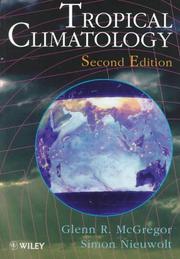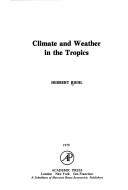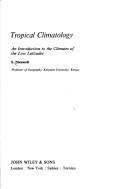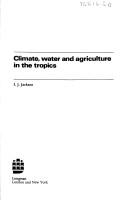| Listing 1 - 7 of 7 |
Sort by
|

ISBN: 0471966118 047196610X 9780471966111 Year: 1998 Publisher: Chichester: Wiley,
Abstract | Keywords | Export | Availability | Bookmark
 Loading...
Loading...Choose an application
- Reference Manager
- EndNote
- RefWorks (Direct export to RefWorks)
Tropics --- Climate --- Basic Sciences. Meteorology --- Climatology --- Climate. --- Climatology. --- Tropics - Climate

ISBN: 0125881800 9780125881807 Year: 1979 Publisher: London: Academic press,
Abstract | Keywords | Export | Availability | Bookmark
 Loading...
Loading...Choose an application
- Reference Manager
- EndNote
- RefWorks (Direct export to RefWorks)
Tropics --- Climate --- Climate. --- Geografie --- Fysische geografie --- Klimaat --- (Klimatologie, Meteorologie, Klimaatsveranderingen) --- (Klimatologie, Meteorologie, Klimaatsveranderingen). --- Tropics - Climate

ISBN: 0471994065 9780471994060 Year: 1978 Publisher: Chichester Wiley
Abstract | Keywords | Export | Availability | Bookmark
 Loading...
Loading...Choose an application
- Reference Manager
- EndNote
- RefWorks (Direct export to RefWorks)
Tropics --- -551.58 <213.5> --- 631.95 --- 631.95 Agrarian ecology --- Agrarian ecology --- Climate --- Climatology--Tropical regions. Torrid zone. Tropics --- 551.58 <213.5> --- Climate. --- Tropics - Climate
Book
ISBN: 2852031140 9782852031142 Year: 1983 Publisher: Paris : Editions Honoré Champion,
Abstract | Keywords | Export | Availability | Bookmark
 Loading...
Loading...Choose an application
- Reference Manager
- EndNote
- RefWorks (Direct export to RefWorks)
Africa --- Tropics --- Equatorial regions --- Equatorial zones --- Subtropical regions --- Subtropics --- Tropical regions --- Tropical zones --- Zones, Equatorial --- Zones, Tropical --- Earth (Planet) --- Eastern Hemisphere --- Climate. --- Climate --- (66/67) SUB SAHARIAN STATES --- 551.58 CLIMATE --- 912 CARTOGRAPHY --- Charts, diagrams, etc. --- Africa - Climate --- Africa - Climate - Charts, diagrams, etc. --- Tropics - Climate --- Tropics - Climate - Charts, diagrams, etc.

ISBN: 0582485290 0582485282 9780582485297 9780582485280 Year: 1977 Publisher: London : Longman,
Abstract | Keywords | Export | Availability | Bookmark
 Loading...
Loading...Choose an application
- Reference Manager
- EndNote
- RefWorks (Direct export to RefWorks)
Plant-water relationships --- Water in agriculture --- Tropics --- Climate --- Tropical zones --- climate --- water --- Agriculture --- agriculture --- Plant water relations --- environmental factors --- environment --- Climatology --- Plants and water --- Water and plants --- Water-plant relationships --- Soil moisture --- Water-supply, Agricultural --- Water-supply, Rural --- Climate. --- Régions tropicales --- Climat --- agriculture. --- Plant-water relationships - Tropics --- Water in agriculture - Tropics --- Tropics - Climate
Book
ISBN: 3642250289 3642250297 9786613574671 128039675X Year: 2012 Publisher: Berlin, Heidelberg : Springer Berlin Heidelberg : Imprint: Springer,
Abstract | Keywords | Export | Availability | Bookmark
 Loading...
Loading...Choose an application
- Reference Manager
- EndNote
- RefWorks (Direct export to RefWorks)
This theses is presented in two parts: development and testing of a new approach to detecting and tracking tropical cyclones in climate models; and application of an extreme value statistical approach to enable assessment of changes in weather extremes from climate models. The tracking algorithm applied a creative phase-space approach to differentiate between modeled tropical cyclones and their mid-latitude cousins. Special attention was paid to the considerable sensitivity of parameters. One major finding was that changes over time were relatively insensitive. This new approach will improve and add confidence to future assessments of climate impacts on hurricanes. The Extremes Approach utilized the Generalized Pareto Distribution, one of the standard approaches to statistics of extremes. This method was applied to present and future hurricane distributions as modeled by a regional climate model. The results have been compared with current observations on changes in weather extremes. The author came to the conclusion that the Extremes Approach provides an excellent method of determining weather extremes, whereas it is still difficult to directly resolve these extremes using climate models. The results of this thesis are of considerable societal importance: Detailed knowledge about hurricane characteristics and their progression enable decision-takers to plan and adapt evacuation strategies.
Climatic changes -- Environmental aspects. --- Tropics -- Climate. --- Typhoons. --- Cyclone forecasting --- Climatology --- Meteorology --- Earth & Environmental Sciences --- Meteorology & Climatology --- Mathematical models --- Statistical methods --- Mathematical models. --- Cyclones --- Forecasting, Cyclone --- Forecasting --- Earth sciences. --- Meteorology. --- Atmospheric sciences. --- Computer simulation. --- Earth Sciences. --- Atmospheric Sciences. --- Simulation and Modeling. --- Computer modeling --- Computer models --- Modeling, Computer --- Models, Computer --- Simulation, Computer --- Electromechanical analogies --- Simulation methods --- Model-integrated computing --- Aerophysics --- Atmospheric sciences --- Physical meteorology --- Geophysics --- Aerology --- Earth sciences --- Atmosphere --- Geosciences --- Environmental sciences --- Physical sciences --- Weather forecasting --- Atmospheric science
Book
ISBN: 1441994572 1441994580 Year: 2011 Publisher: New York, NY : Praxis : Imprint: Praxis,
Abstract | Keywords | Export | Availability | Bookmark
 Loading...
Loading...Choose an application
- Reference Manager
- EndNote
- RefWorks (Direct export to RefWorks)
The stratosphere is the highest layer of Earth's atmosphere where aircraft can still fly. The density of the air is just high enough here to generate lift on a wing or buoyancy on a balloon, so designing any stratospheric aircraft is a delicate technological balancing act for the engineer. Designing and operating an aircraft capable of conveying humans to the stratosphere is more challenging still: biologically, we simply do not belong up there. Temperatures often as low as -80C (-112F) and an ambient pressure rapidly diminishing with altitude make for an extremely forbidding environment. In fact, as we pass 50 000 feet (the lower end of Concorde's cruising altitude range), we enter the space equivalent zone - from a physiological point of view we might as well be in low Earth orbit. The fact that stratospheric flight is possible at all - moreover, even safe and economical, at least in the lower stratosphere - is made possible by some relatively recent advances in our understanding of the science of high altitude flight. This book charts some of these developments; at the same time, it is a catalog of ways in which the stratosphere can catch out even the well-prepared flyer. Naturally, the failures of early explorers have signposted many of these dangers, but, as regular news headlines and the series of vignettes that punctuate the book illustrate, the learning curve has not levelled off, it has merely become shallower. Stratospheric flight is still aviation at the limit.
Aeronautics. --- Mesosphere. --- Stratosphere. --- Tropics -- Climate. --- Aeronautics --- Stratosphere --- Altitude, Influence of --- Aerothermodynamics --- Mechanical Engineering --- Engineering & Applied Sciences --- Aeronautics Engineering & Astronautics --- Research --- Stratopause --- Aerostation --- Air navigation --- Aviation --- Engineering. --- Space sciences. --- Popular works. --- Aerospace engineering. --- Astronautics. --- Aerospace Technology and Astronautics. --- Popular Science, general. --- Extraterrestrial Physics, Space Sciences. --- Chemosphere --- Communication and traffic --- Aerodynamics --- Airships --- Astronautics --- Balloons --- Flight --- Flying-machines --- Science (General). --- Astrophysics. --- Space Sciences (including Extraterrestrial Physics, Space Exploration and Astronautics). --- Astronomical physics --- Astronomy --- Cosmic physics --- Physics --- Space sciences --- Astrodynamics --- Space flight --- Space vehicles --- Aeronautical engineering --- Engineering --- Science and space --- Space research --- Cosmology --- Science
| Listing 1 - 7 of 7 |
Sort by
|

 Search
Search Feedback
Feedback About
About Help
Help News
News